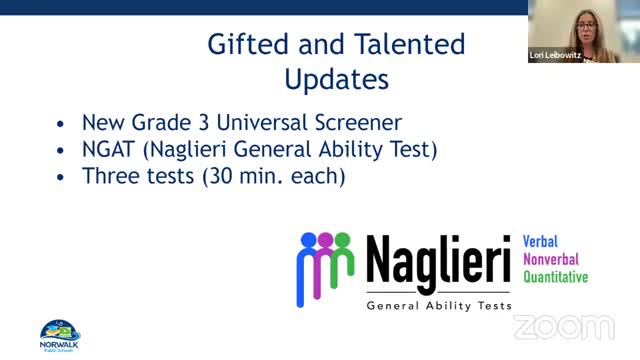New assessment revolutionizes identification of gifted students
September 11, 2024 | Norwalk School District, School Districts, Connecticut
This article was created by AI summarizing key points discussed. AI makes mistakes, so for full details and context, please refer to the video of the full meeting. Please report any errors so we can fix them. Report an error »

In a recent government meeting, educators discussed the implementation of a new assessment tool aimed at identifying gifted students without the influence of language. The assessment, developed by Jack Naglieri, expands from a single nonverbal test to a comprehensive three-part evaluation that includes verbal and quantitative components, all designed to measure students' natural abilities.
The new verbal section utilizes pictures to assess students' understanding of relationships among images, eliminating the need for oral or written instructions. The quantitative assessment focuses on patterns and basic math concepts, presented through visual symbols rather than word problems. This approach aims to provide a clearer picture of students' cognitive abilities, particularly for those who may struggle with traditional language-based assessments.
The assessments will be administered to all third graders in October, allowing educators to quickly analyze results and form talent development groups without the lengthy wait associated with previous testing schedules. The goal is to identify students' strengths early in the academic year, enabling timely enrichment opportunities.
Educators emphasized the importance of using data to inform decisions regarding student support and enrichment. The new assessment is expected to enhance understanding of students' potential, particularly in areas like mathematics, where targeted enrichment can be provided based on individual strengths.
While the new assessment is currently limited to third graders, educators are hopeful that future norms will allow for its use in middle school settings as well. The meeting concluded with a positive outlook on the assessment's potential to engage students in a fun and challenging way, fostering a deeper understanding of their abilities beyond traditional testing methods.
The new verbal section utilizes pictures to assess students' understanding of relationships among images, eliminating the need for oral or written instructions. The quantitative assessment focuses on patterns and basic math concepts, presented through visual symbols rather than word problems. This approach aims to provide a clearer picture of students' cognitive abilities, particularly for those who may struggle with traditional language-based assessments.
The assessments will be administered to all third graders in October, allowing educators to quickly analyze results and form talent development groups without the lengthy wait associated with previous testing schedules. The goal is to identify students' strengths early in the academic year, enabling timely enrichment opportunities.
Educators emphasized the importance of using data to inform decisions regarding student support and enrichment. The new assessment is expected to enhance understanding of students' potential, particularly in areas like mathematics, where targeted enrichment can be provided based on individual strengths.
While the new assessment is currently limited to third graders, educators are hopeful that future norms will allow for its use in middle school settings as well. The meeting concluded with a positive outlook on the assessment's potential to engage students in a fun and challenging way, fostering a deeper understanding of their abilities beyond traditional testing methods.
View full meeting
This article is based on a recent meeting—watch the full video and explore the complete transcript for deeper insights into the discussion.
View full meeting
